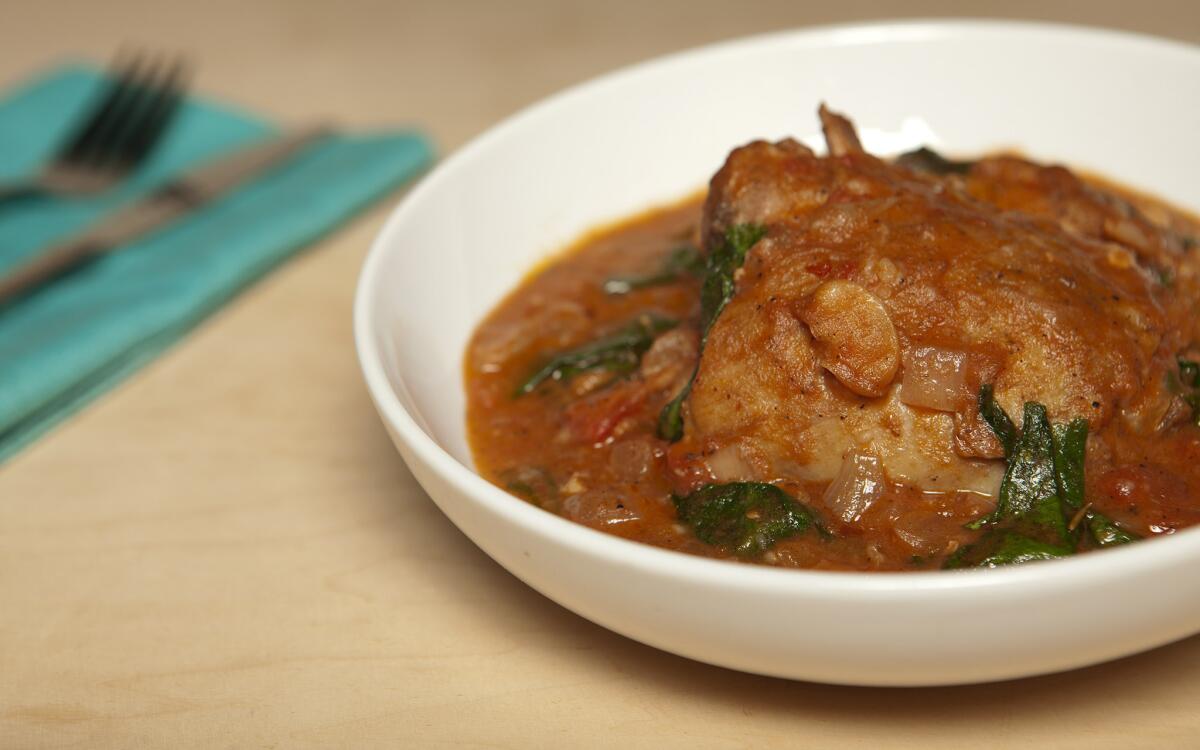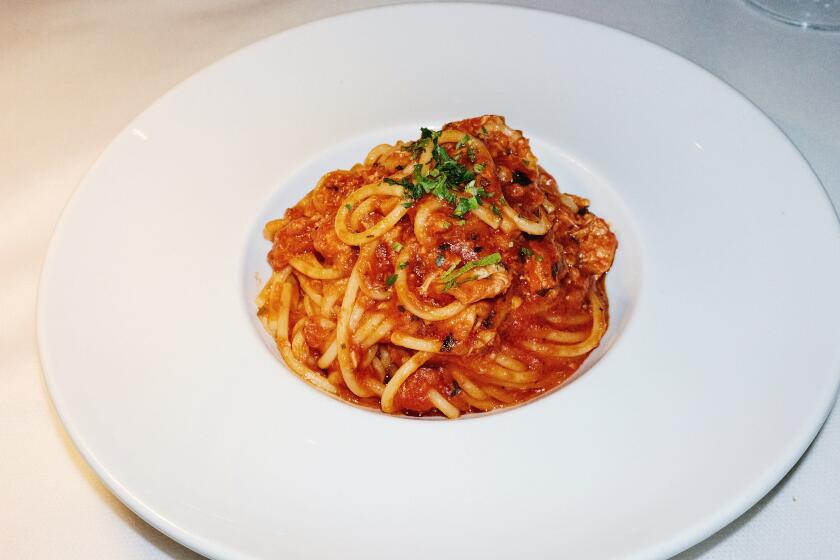Tuscan chicken stew

Here’s the deal: You know a lot about food. You’ve seen all the shows; you’ve read all the books. On Chowhound you’re a god. You love Vinny and Jon and Lindy and Grundy, and you always -- always -- get your reservation at LudoBites. But when it comes to cooking, well, there’s a little problem.
It’s not that you can’t cook; it’s just that what you do in your own kitchen doesn’t really match up to your aspirations. You dream of flying, but you’re finding it hard to get off that skateboard.
A library full of cookbooks doesn’t help. Trying to learn to cook by trolling through recipe collections is frustrating. Even after you’ve mastered a dish, all you’ve really learned is how to make that one thing. At that rate, you’ll probably be retired before you feel like you’ve actually mastered the art.
What you need is a book that will teach the basics and hopefully provide some pretty good food while you’re learning. Fortunately, there are two really good new books that aim to do just that. They’re very different, intended for completely different audiences, but each accomplishes what it sets out to do -- make you a better cook.
The first, aimed at those just getting started, comes from what may be a somewhat surprising source. While the Food Network these days seems geared mainly to contrived competitions and really loud people with unfortunate hair, the book based on the “How to Boil Water” series delivers a lot of solid culinary advice along with recipes that will appeal -- or at least be acceptable -- even to sophisticated diners.
On the other hand, for cooks who have mastered the basics and have set their sights on more ambitious terrain, there’s Michael Ruhlman’s “Ruhlman’s Twenty,” neatly summed up in the subtitle “20 Techniques; 100 Recipes; A Cook’s Manifesto.”
Full disclosure time: As happens when you work in the same field long enough, I know people involved in both books. Food Network test kitchen director Katherine Alford and I worked on a television show together several years ago. Ruhlman and I are old friends, and he has contributed to The Times’ Food section. That shouldn’t be held against either of them.
“How to Boil Water” seems to be aimed at the college or immediately post-college crowd (indeed, the subtitle is “Life Beyond Takeout”). It’s got all the flashy colors, funny fonts and well-scrubbed prepster models you might expect.
--
All the basics
But there’s a lot more to the book than just shiny surfaces. The requisite little breakout boxes contain a lot of sound information on how to shop for food, how to store it, how to set up your first kitchen and more. I found especially sweet one on how to seat people at a dinner party, focusing on how to draw out the quiet guest.
The recipes are a lot better than you probably have any right to expect from a book obviously aimed at the cook who has only a fleeting acquaintance with the kitchen. The Tuscan chicken I fixed was completely satisfying -- essentially chicken thighs braised with white beans in a light tomato sauce and finished with fresh spinach and lots of grated Parmigiano-Reggiano.
Skeptics might well point out that any recipe containing a half-cup of grated Parm is pretty much bound to be good, to which I would respond: “And can you think of a better lesson for a beginning cook?”
“Ruhlman’s Twenty” is aimed at the kind of hard core who might sneer at the noob satisfied by “How to Boil Water.” When the author calls it a “manifesto,” he’s not kidding. At times, in fact, it reads like a chef lecturing a particularly slow commis. Coauthor of books with such chefs as Thomas Keller and Eric Ripert, and coauthor of another book on making charcuterie at home, Ruhlman makes it clear he is going for the ambitious home cook, someone for whom the kitchen is as much a hobbyist’s workshop as it is a place of necessity.
The idea is that by isolating 20 essential building blocks of cooking and then going into some depth on them, Ruhlman can impart what you need to know to be a better cook, even a sense of the craft of cooking. He succeeds to a remarkable extent. There is so much good information in “Twenty,” and even more good sense. It is clearly the product of years of cooking and of thinking about cooking (indeed, the first building block, the keystone of the book, is titled “Think”).
It’s the kind of book I can see culinary acolytes, those hardy souls dreaming of one day cooking their way through “The Complete Robuchon,” taking to bed at night to read and reread, each time getting a little more.
Just as an example, the second chapter, on salting, covers what kind of salt to use (coarse kosher for most things), finishing salts such as Maldon or fleur de sel, the importance of salting all through the cooking process rather than just at the end, the effect of salting on meat, fish and fruit and vegetables, salting cooking water, salting fat-based sauces, using salt substitutes such as anchovies and fish sauce, salting baked goods, using brines, and preserving with salts.
It’s masterful -- an authoritative essay on an aspect of cooking that most recipes wrap up with “season to taste.” Other building blocks include water, onions and acid, equally obvious-sounding topics that nevertheless get you to reexamine what you think you know about an aspect of cooking.
Clearly, this level of detail is not aimed at the cook who just wants to impress a date on Saturday night. And in fact, Ruhlman expects you to earn your kitchen stripes. While there are plenty of home-style recipes in the book, they’re usually given some kind of chef-y twist. Even simple mac ‘n’ cheese is bound with soubise -- white sauce pureed with plenty of caramelized onions.
And he’s not at all shy about calling for ingredients that may be a bit of a challenge to find. His delicious-sounding winter vegetable garbure is simmered under an eight-inch sheet of bacon rind. Sounds amazing, even though acquiring that rind might be an issue (unless, of course, you make your own bacon, as Ruhlman recommends).
Recipes are not arranged in traditional soup-to-nuts fashion, but as they apply to the essays. The salt chapter, for example, includes raw zucchini salad (salted to draw out moisture), brined pork chops, preserved lemons, homemade bacon, gravlax and a caramel sundae with extra-coarse salt.
As it happens, when it comes to food lovers just learning to cook, I have a test case of my own at home. No, she didn’t just graduate from high school or college, or move out on her own, but my wife just retired from her job. And now, after 30 years of never making much more than breakfast granola and the occasional cheese quesadilla, she’s decided she’d like to start fixing dinner every now and then.
I gave her a copy of “How to Boil Water” and told her to go crazy, figuring the worst that could happen would be that we’d end up eating at Bake ‘n’ Broil again. But when I got home that night, she’d made chicken with dates and green olives (“Date Night Chicken” in the book), and couscous with carrots and raisins. She had been a little nervous, she said, “but it turned out to be really fun.”
She then propped the dishes up on the counter and took pictures with her iPhone to show her friends. Next thing you know, she’ll be starting a blog.
Chop the onion; smash and peel the garlic. Rinse and drain the beans in a colander or strainer.
Heat a Dutch oven over medium-high heat. Pat the chicken dry with paper towels and season all over with salt and black pepper. Add the oil to the Dutch oven. When the oil is hot, add the chicken skinned (rounded) sides down, and brown, in batches if necessary, about 4 minutes per side. Transfer to a platter when done.
When all the chicken has been browned, reduce the heat to medium, add the onion, garlic, red pepper flakes and herbs; cook, stirring until the onions are slightly soft, about 5 minutes. Stir in the tomato paste and cook until brick red, about 1 minute. Add the wine and use a wooden spoon to scrape up any brown bits that cling to the pan. Bring to a boil and cook until syrupy, about 1 minute.
Add the beans, tomatoes and chicken broth, and bring to a boil. Nestle the chicken pieces in the stew, adding to the pan any collected juices from the plate. Simmer the stew, uncovered, until the chicken is cooked through, about 20 minutes.
Trim the escarole and tear the leaves into bite-size pieces. (If you’re using baby spinach, there’s no need to do this.) Wash the escarole or spinach and drain. Add the greens to the stew, cooking only until wilted, about 4 minutes. Stir in the cheese and season with salt and black pepper to taste. Serve in shallow bowls.
Get our Cooking newsletter.
Your roundup of inspiring recipes and kitchen tricks.
You may occasionally receive promotional content from the Los Angeles Times.
















